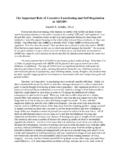Transcription of Russell A. Barkley, Ph.D. - Russell Barkley
1 Skills rating system. Circle Pines, MN: Amer-ican Guidance Moore, S., DuPaul, , &White, (2006). The effects of self man-agement in general education classroomson the organizational skills of adolescentswith Modification, 30,159 , , Jensen, , Arnold, ,Roper, M., Sever, J., et al. (2004). Reliabilityof the Services for Children and Adoles-cents Parent of the Ameri-can Academy of Child and AdolescentPsychiatry, 43(11), 1345 , , Applegate, B., McBurnett, K.,Biederman, J., Greenhill, L., Hynd, , etal. (1994). DSM IV field trials for attentiondeficit hyperactivity disorder in childrenand Journal of Psychi-atry, 151,1673 , , Smith, , Bogle, ,Schmidt, ,Cole, ,&Pender,C.(2006). A pilot evaluation of small groupChallenging Horizons Program: A random-ized of Applied School Psychol-ogy, 23(1), 31 , , Pelham, , Blumenthal,J.
2 , & Galiszewski, E. (1998). Agreementamong teachers behavior ratings of adoles-cents with a childhood history of attentiondeficit hyperactivity ofClinical Child Psychology, 27, 330 , ,Evans, ,Gnagy, ,&Greenslade, (1992). Teacher ratings ofDSM IIIR symptoms for the disruptive be-havior disorders: Prevalence, factor analy-ses, and conditional probabilities in aspecial education PsychologyReview, 21, 285 , ,Gnagy, ,Greiner, ,Hoza, B., Hinshaw, , Swanson, , etal. (2000). Behavioral versus behavioral andpharmacological treatment in ADHD chil-dren attending a summer treatment of Abnormal Child Psychology,28(6), 507 , Greenhill, , Crismon, ,Sedillo, A., Carlson, C., Conners, , et al.(2000). The Texas Children s MedicationAlgorythm of the AmericanAcademy of Child and Adolescent Psychiatry,39(7),920 , V.
3 L., & Chronis, A. M. (2006). Inter-ventions to address the academic impair-ment of children and adolescents Child and Family PsychologyReview, 9, 85 , , & Kamphaus, (1993).Behavior assessment system for , MN: American Guidance , , Evans, , & Serpell, (2008).Preventing failure among middle schoolstudents with ADHD: A survival under review for , ,DuPaul, ,Bradley, ,&Bailey, (1995).A school based consulta-tion program for service delivery to middleschool students with ADD(manual and vid-eotape). Austin, TX: Pro MTA Cooperative Group. (1999).14 month randomized clinical trial of treat-ment strategies for attention deficit hyper-activity of GeneralPsychiatry, 56, 1073 MTA Cooperative Group. (2004).
4 Na-tional Institute of Mental HealthMultimodal Treatment Study of ADHD fol-low up: 24 month outcomes of treatmentstrategies for attention deficit/hyperactiv-ity , 113,754 , D., Charach, A., & Schachar,R. J. (2001). Moderators and mediators oflong term adherence to stimulant treat-ment in children with of theAmerican Academy of Child and AdolescentPsychiatry, 40,922 , , Wibbelsman, , Brown, ,Evans, ,Gotlieb, ,Knight, , et al. (2005). Attention deficit hyperac-tivity disorder in adolescents: A review ofthe diagnosis, treatment and clinical , 115(6), 1734 Accommodationsfor Children with ADHDR ussell A. Barkley , my workshops on ADHD, Ishare with educators a long list of rec-ommendations, most from research,that they can use to help manage stu-dentswithADHD inschoolsettingsapart from, or in addition to, theirADHD medications.
5 Underlying theserecommendations are nine principlesthat need to be considered for the plan-ning and management of programs forchildren and teens with ADHD(Pfiffner, Barkley , & DuPaul, 2006).Here are those nine principles fol-lowed by my management Rules and instructions provided to chil-dren with ADHD must be clear, brief,and often delivered through more visi-ble and external modes of presentationthan are required for the managementof children without directions clearly, having thechild repeat them out loud, having thechild utter them softly to themselveswhile following through on the instruc-tion, and displaying sets of rules orrule prompts ( , stop signs; big eyes,big ears for stop, look, and listen re-minders) prominently throughout the 2008 The Guilford PressThe ADHD Report 7classroom are essential to proper man-agement of ADHD children.
6 Relying onthe child s recollection of the rules aswell as upon purely verbal reminders isoften Consequences used to manage the behav-ior of ADHD children must be deliveredswiftly and more immediately than isneeded for children without in consequences greatly de-grade their efficacy for ADHD of consequences with chil-dren with ADHD must be more sys-tematic and is far more crucial to theirmanagement than in normal is not just true for rewards, but isespecially so for punishment, whichcan be kept mild and still effective bydelivering it as quickly after the misbe-havior as possible Swift, not harsh,justice is the essence of Consequences must be delivered morefrequently, not just more immediately,to children with ADHD in view of theirmotivational tracking, or the ongoingadherence to rules after the rule hasbeen stated and compliance initiated,appears to be problematic for childrenwith ADHD.
7 Frequent feedback orconsequences for rule adherenceseem helpful in maintaining appro-priate degrees of tracking to rulesover The type of consequences used with chil-dren with ADHD must often be of ahigher magnitude, or more powerful,than that needed to manage the behav-ior of other relative insensitivity of them to re-sponse consequences dictates thatthose chosen for inclusion in a behaviormanagement program must have suffi-cient reinforcement value or magni-tude to motivate children with ADHDto perform the desired behaviors. Suf-fice to say, then, that mere occasionalpraise or reprimands are simply notenough to effectively manage childrenwith An appropriate and often richer degreeof incentives must be provided within asetting or task to reinforce appropriatebehavior before punishment can be means that punishment must re-main within a relative balance with re-wards or it is unlikely to succeed.
8 It istherefore imperative that powerful re-inforcement programs be establishedfirst and instituted over 1 to 2 weeks be-fore implementing punishment in or-der for the punishment, sparinglyused, to be maximally effective. Oftenchildren with ADHD will not improvewith the use of response cost or time outif the availability of reinforcement islow in the classroom, and hence re-moval from it is unlikely to be punitive. Positives before negatives is the or-der of the day for children with punishment fails, this is the firstarea which clinicians, consultants, oreducators should explore for problemsbefore instituting higher magnitude ormore frequent punishment Those reinforcers or particular rewardsthat are employed must be changed orrotated more frequently for ADHD children than for those without ADHD,given the penchant of the former formore rapid habituation or satiation toresponse consequences, apparently re-wards in means that even though a partic-ular reinforcer seems to be effectivefor the moment in motivating childcompliance.
9 It is likely that it will loseits reinforcement value more rapidlythan normal over time. Rewardmenus in classes, such as those usedto back up token systems, must there-fore be changed periodically, say ev-ery 2 to 3 weeks, to maintain thepower or efficacy of the program inmotivating appropriate child behav-ior. Failure to do so is likely to result inthe loss of power of the reward pro-gram and the premature abandon-ment of token technologies based onthe false assumption that they simplywill not work any longer. Token sys-tems can be maintained over an entireschool year with minimal loss ofpower in the program provided thatthereinforcersarechangedfre-quently to accommodate to this prob-lem of habituation.
10 Such rewards canbe returned later to the program oncethey have been set aside for awhile,often with the result that their rein-forcement value appears to have Anticipation is the key with means that teachers must be moremindful of planning ahead in manag-ing children with this disorder, particu-larly during phases of transition acrossactivities or classes, to insure that thechildren are cognizant of the shift inrules (and consequences) that is aboutto occur. It is useful for teachers to takea moment to prompt a child to recall therules of conduct in the upcoming situa-tion, repeat them orally, and recall whatthe rewards and punishments will be inthe impending situationbeforeenteringthat activity or aloud,think aheadis the important message toeducators here.



